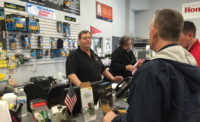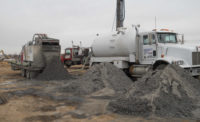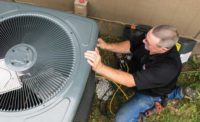The year is drawing to a close, and contractors are working hard to log those last sales before the books are shut on 2016. It certainly was an interesting year with record-high temperatures in the summer and an equally scorching presidential campaign that seemed to go on forever. While the former spurred sales of replacement equipment in many areas, some contend the latter was a drag on the economy as uncertainty may have led consumers to keep their wallets shut tight.
What the Trump presidency portends for the future is anyone’s guess, but contractors have definite opinions about how their businesses fared in 2016 and what they’re concerned about in 2017.
SALES AND SERVICE
Count Brian J. Bovio, president and CEO of Bovio Heating Plumbing Cooling Insulation in Sicklerville, New Jersey, as one who is looking forward to 2016 coming to an end. “We were projecting growth this year, and this winter was one of the worst in our 42 years in business. While the summer helped, it still was not what we would have hoped for given the extreme heat we experienced. I think the presidential election and other world events left consumers somewhat rattled and reluctant to make large investments in their homes right now.”
Bovio saw a slight decrease in the number of units sold this year but a marked decrease in revenue due to clients buying more cooling- or heating-only equipment as opposed to full system replacements. Customers also chose more minimum-efficiency equipment with fewer features (e.g., variable speed, multiple stages) than in recent years, which caused the company to miss its 2016 sales forecast.
“As a reaction to the slow winter, we did expand our marketing efforts to more online sources to try and drum up business, and that began to pay dividends for us later in the year,” said Bovio. “If I could have done one thing differently, it would have been to focus more on our existing client base as opposed to outward marketing.”
That is exactly what Jason Ellington, president of Ellington Air Conditioning & Heat in Rockledge, Florida, focused on most recently. “Many of us focus primarily on customer acquisitions, but very few of us really focus on customer retention. An unconventional approach we started a few years ago was to place our customers into two buckets: In Bucket 1 are those you wish to work for, and in Bucket 2 are those you want your competition to have.”
Ellington identifies Bucket 2 customers as those who dispute the bill every time and most often are slow payers, do-it-yourselfers, and/or chronic complainers. With a renewed focus on Bucket 1 customers, Ellington experienced some growth this year in both sales and service.
“We really changed the way we approached service calls, as well,” he said. “Instead of the traditional method of giving customers one choice, we give them five and ask, ‘What do you want us to do?’ That makes it the customers’ decision and not our tech’s.”
Abnormally warm weather helped spur sales at Aire Serv of Las Vegas, which experienced a 12 percent increase this year. “That was in line with our forecast for the year,” said Jeremy Anderson, general manager, Aire Serv of Las Vegas. “The weather was really weird and seems to be getting weirder. It was still hot in November, so we were running ads for air conditioners. Usually, we are running ads for furnaces at that point.”
While the weather certainly helped, Anderson also believes that better training and an improving economy resulted in better sales for the year. He noted the company has been spending more time training technicians to present a variety of options to customers, and, as a result, customers are choosing to replace their systems rather than repair them. That being said, he would have liked to have seen higher sales for the year. “We’re content, but we would’ve been happy with more,” Anderson said.
That sentiment is also shared by Dennis Sullivan, vice president and CEO of CARE Heating and Cooling in Westerville, Ohio. “Our sales this year exceeded our expectations, which we are very excited about, and our service calls have also increased year over year. We’re pleased with our results but we’re always striving to do better.”
This year, Sullivan focused on improving operational efficiencies as well as increasing the company’s ability to respond to same-day requests for service. To do that, office hours were expanded to 7 a.m. to 8 p.m., seven days a week, which is in stark contrast to most competitors that close at 5 p.m. on weekdays and are not even open on weekends. “Expanding our hours allowed us to provide a better customer service experience and made it easier for customers to do business with CARE. At CARE, we feel an obligation to our customers to be there when they need us.”
LABOR CHALLENGES
Looking at 2017, all contractors pointed to the same concern: finding and retaining skilled workers. “The biggest challenge we are facing now — and will continue to face in the future — is employees coming and going,” said Anderson. “We are constantly seeing technicians leave and start companies of their own. I think they see how much the cost of the equipment is compared to what we charge for an installation, and they think we are pocketing the difference. But what they are not considering is all the costs associated with the business.”
Another problem Anderson identified is that the technicians he sees entering the business are not always of the same caliber as those who are preparing to retire. “The older techs who have been doing this for 20 years or more can diagnose problems and fix them in no time,” said Anderson. “The kids coming out of the six-month vo-tech programs think they can take on the world, and they can’t fix a ham sandwich. That’s a challenge.”
Finding good employees is a challenge for every company, noted Sullivan, who is looking to fill positions in nearly every area of his company. “For as long as I have been involved in this industry, data from trade groups and government organizations have shown that the labor market for skilled trades is shrinking nationwide. Our labor market in central Ohio is no exception, which is why we have found a need to ‘grow our own’ rather than exclusively recruit employees who have experience or an education in HVAC. We are experimenting with different training methods, but the key is to hire individuals with great attitudes who fit with our company culture.”
“Finding qualified technicians is a definite challenge,” Bovio agreed. “We now hire outside the industry based on character and aptitude and train them in house, which has worked well for us. But it does not help when there is an immediate need for qualified help, so that remains a challenge.”
While hiring and retaining employees can be a challenge, making sure the company culture is positive and supportive is just as important, noted Ellington. “Our challenges and concerns going into 2017 are the same as every year. First, we want to find ways to improve the customer experience, and second, we want to focus on how to improve our company culture. One way of doing that is to not let bad apples stay in the bunch because that becomes contagious. If you have bad apples, improve the hiring process to ensure the company culture remains positive and supportive.”
Staying positive can be a challenge, especially when key employees leave, and it is difficult to find people to fill their shoes. But by creating and maintaining a supportive environment, quality employees will hopefully choose to stay put rather than venture out into the unknown. That is definitely a worthwhile goal for 2017.
Want more HVAC industry news and information? Join The NEWS on Facebook, Twitter, and LinkedIn today!








